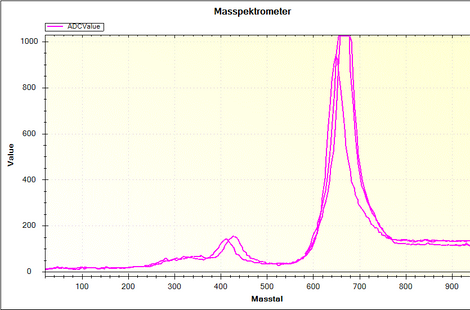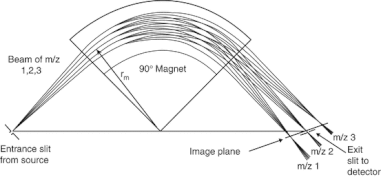My home built mass spectrometer
What can a mass spectrometer do?
A mass spectrometer separates molecules of different mass and presents the result as a graph.
- The high peak is nitrogen at mass 28
- The smaller peak is water at mass 18
To the left of this are two badly separated peaks, probably:
- OH at mass 17 and oxygen atoms at mass 16.
- These are fragments of water created within the spectrometer.
What makes it work?
The Ion Source
- A heated filament supplies electrons, that are accelerated towards a collector by an electric field.
- On their way towards the collector, they collide with gas molecules within the vacuum system. Electrons are stripped from the gas molecules, creating positively charged ions.
- These ions are drawn and accelerated out into the mass spectrometer by a negative electric field.
The Magnetic Sector
- The ions coming from the source passes a narrow slit, and then into the magnetic field, in the form of a 90 degree sector.
- The ions are deflected in the magnetic field, according to their mass and the strength of the electric field.
- By sweeping the strength of the electric field, ions of different mass are able to pass through the exit slit.
- They are focused by the sector magnet at the exit slit.
The Ion Detector
- The ions passing the exit slit are collected by an electrode, formed as a faraday cup.
- A very sensitive current amplifier converts the tiny current from the faraday cup to a voltage, that corresponds to the abundance of ions of a certain mass.
- This is presented as an XY-graph, with the mass on the X-axis and the abundance on the Y-axis.
Why did I build it?
- I wanted to be able to leak check my electrical feed throughs, before I incorporated them into my Crooke´s tubes and other evacuated discharge tubes that I make.
- Leak testing with helium is an established and very effective method, that can be done with a mass spectrometer.
- It could be built as a permanent addition to my vacuum system.
- Not many DIY mass spectrometers have been built, so it was a challenge.
- I already had the vacuum system, and I had some ideas how it could be done.
I was inspired by a few other sucessful amateur efforts on the internet:



